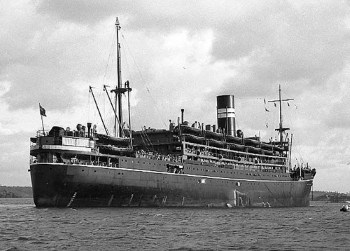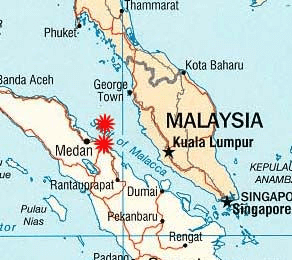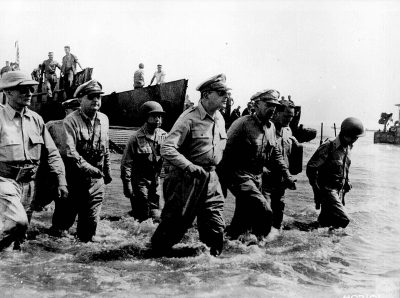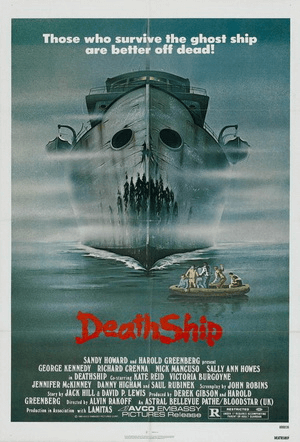
THE DEAD TIMES
DEAD ARE COMING...
Zombie Crier - The SS Ourang Medan
It's time again to delve the rotten, infected nose of Zombiism into events so bizarre that, to this day, no concrete explanation has been given. Yes, it's time for another article of Zombie Crier - my, and hopefully yours too, favourite wordplay series where I transfuse known facts with hideous undead, determining whether or not Zombies were behind the mysteries of our scientific world.
This week, I make waves about the peculiar and disturbing story of the SS Ourang Medan - the so-called "death ship" that has a tale so unearthly, many choose to believe it simply did not exist at all.
What is the SS Ourang Medan?
The Ourang Medan, or "Man from Medan" as loosely translated to Indonesian (Indonesia being the alleged origin of the ship), is a Dutch ocean going vessel - not a navy frigate or gunboat but a simple merchant vessel. What it is, or was, is not really important - the purpose of this article is to introduce you to the extremely chilling events that surround it.

© What the Ourang Medan may have looked like | Death Ship: The Ourang Medan Mystery
At some point in June 1947 (two years after the second World War concluded), two American ships, the City of Baltimore and the Silver Star, intercepted a Morse code transmission from the Ourang Medan. That message was as follows:
"S.O.S. from Ourang Medan * * * We float. All officers including the Captain, dead in chartroom and on the bridge. Probably whole of crew dead * * *."
Seconds later, a garbled bunch of dots and dashes came through on the listening ships' receivers. Then, a final broadcast was picked up:
"I die."
Silence followed this transmission and no further communication from the stricken Ourang Medan was detected. Naturally, the Sliver Star raced to the scene, attempting a rescue of the ship under duress. They found the vessel undamaged and there were not external signs of the freighter being boarded - it was only when they got inside did the catastrophe reveal itself. The interior of the ship was lousy with corpses, including that of the ship's dog.
All the corpses were frozen in fear, their mouths gaping and eyes wide open, lying on their backs as if blown backwards to the deck. They had no injuries and are quoted as being like "horrible caricatures". The body of the crewman who sent the unnerving distress message was found with his hand still on the Morse code device, his body, like the other corpses, rigid with fear. With so many dead, the chance of finding others left alive seemed slim so the boarding party from the Silver Star shifted their attention to uncovering the cause of the mysterious deaths - along with finding any survivors hidden within the bowels of the ship.
No sooner did they set out with renewed purpose, the Ourang Medan, somehow, caught fire. The fire started in the number four cargo hold and spread quickly, forcing the boarders off the Dutch freighter and back to the nearby Sliver Star. Soon after, the flaming ship exploded and sunk, the fire having spread to the fuel compartments.

© The alledged source of the transmissions | Death Ship: The Ourang Medan Mystery
There the story would end but, a year after the event, in 1948, a Dutch newspaper ran an article where a supposed survivor of the Ourang Medan disaster spoke out about the bizarre events. He says that the ship was stopped, mid-voyage. Cargo, with an apparent military background, loaded aboard in this brief, unscheduled stop and, when sailing resumed, after a few hours, all crew suddenly dropped dead.
"The cargo was loaded on the ship from a river mouth (and not a port) and came from what seems to be military camouflaged huts."
Theories
With no evidence left afloat, and such a weird tale, it is perhaps not surprising so many theories surround this unfortunate event, ranging from extraterrestrial attack to the paranormal.
- Ghosts - Bodies frozen in fear, a look of pure dread on their faces, no visible injuries on the corpses; it's easy to see why some people think ghosts and the paranormal are to blame. Perhaps giving credence to this unnatural theory, the boarding party from the Silver Star reportedly told investigators that it was "eerily cold" in the lower decks of the ship.
- Gas poisoning - It has been suggested that the Ourang Medan was involved in the smuggling of volatile chemical agents such as potassium cyanide and nitroglycerin. The theory goes that sea water crept into the ship's hold and mixed with these compounds, creating a deadly toxic gas. The gas billowed through the metal structure of the ship, suffocating or poisoning everyone on board. If the initial substance had been nitroglycerin - this would explain the eventual fire and explosion.
- Electrical fire - If there was a small, undetected fire caused by malfunctioning electronics, this would have caused a build-up of carbon monoxide, eventually killing the crew. As the small fire continued to burn, the flames would have become larger and larger, engulfing the entire vessel. The fire spreads to the fuel compartment and BOOM - down goes the Ourang Medan.
- It never happened - This is perhaps the most popular theory (and, from a conspiratorial standpoint, the most boring). There is no actual evidence that the Ourang Medan even existed in the first place - no official records of construction or mentions of the ship's name in fleet registries. In addition, it seems almost too convenient that almost as soon as the boarding party arrived, the Ourang Medan suddenly caught fire and sank, taking the entire grisly scene to the bottom of the ocean.
Occasionally, I deviate from my Zombie ways (briefly, I assure you). One such foray into other worlds saw me playing an indie horror computer game called Monstrum. In this game, you play an unknown character trapped aboard a ship - all crew members missing (presumed dead), a voracious monster patrolling the halls. The type of monster is one of three, chosen at random - one even bursts onto the ship out of a cargo container. To me, this bares so much resemblance to the case of the Ourang Medan, if the developers did not use it as inspiration, I'd be incredibly surprised.

© Were the military involved? | The Ourang Medan Death Ship
The Zombie Theory
It is actually not that difficult to think of how Zombies could be responsible for the loss of life on the Ourang Medan. The theory begins with the interview of alleged survivor of the incident - the article that reported mysterious cargo being placed on the ship outwith an official port or dock, perhaps having a military origin. To the conspiratorial mind like mine, this reeks of Zombie smuggling. The military would almost certainly have been working on some kind of 'life after death' project. I'm not saying any mad scientist was manufacturing Zombies or brewing potions to reanimate the dead, I simply can't imagine that there was no research into making soldiers fight longer and harder, even after sustaining potentially lethal wounds. Maybe the creation of some serum to automatically pump massive-amounts of adrenaline into the heart when it stopped beating, maybe the military was testing a brain-modification drug to stop soldiers feeling pain or trying to avoid it, who knows. Whatever the military's objectives, there would be side effects. In this tale of terror, I will assume, as so often is the case in the movies, that these side effects manifested as increased aggression, decreased motor function and an appetite for human flesh - in other words, true Zombie behaviour.
Obviously, keeping this technology out of enemy hands would be of utmost importance - troops that do not die as "easily" as regular grunts would be a major advantage to the war effort of any nation and would quickly turn the tide of battle if deployed in the field. Also, it would be of vital importance to maintain hidden from the eye of your own people - both because of the wartime threat of interrogation and the fact that such research into extending human life for the sole purpose of being able to kill more enemies is likely to be seen as highly unethical and immoral.
So, what I think happened was that, on one regular morning in June, the SS Ourang Medan loaded up her cargo as normal, crew members doing their assigned duties in preparation for a sea voyage - something it had done many times before after be conscripted to aid the war effort. The Dutch trawler left port and steamed up the straits of Malacca (the sea gap between Indonesia and Malaysia) - everything on time. Somewhere along the line, the ship was flagged down by a small military vessel, ordering them into a coastal river mouth. There, the crew of the Ourang Medan encountered a small military encampment - not an entire base just a staging area for... as far as the crew of the Ourang Medan knew it was just a temporary troop garrison or coastal terrain survival training camp. However, this small settlement was none of these things - its actual purpose was far more sinister; the storage and distribution of Zombies.
It would make sense to have a Zombie holding area away from wherever this diabolical research was being done. This way, the main hub would be protected from any fallout from Zombies escaping or being seen at the camp. Having it near the mouth of a coastal river is also a smart move; Zombies can be smuggled onto ships in large boxes, the ship's crew assuming it is just some urgently needed weapons or armaments. In addition, if things went south and the camp had to be abandoned, the Zombies could just be shot, their bodies hurled into the ocean, never to be found (also the erosive properties of raging ocean currents would be wonderful for disposing of organic evidence).

© Zombies being used in the army | Zombie Apocalypse Training
Getting back to the Ourang Medan, two of these Zombie boxes, were loaded onto the ship - maybe the crew saw or heard something they could not explain but what were they going to do about it, who were they going to tell while officially "at sea"? The shipmen would have naturally been apprehensive about the new boxes lurking in the cargo hold - it would have been labelled as "Dangerous" and the people at the camp would have no reason not to describe it as such, wanting it to reach its destination but still masking its true nature. The cargo now safely aboard, the Ourang Medan was free to resume its course for whatever destination it was given before the unscheduled diversion.
At some point in the journey to that destination, the boxes broke open - allowing the horrid content access to the steel innards of the trawler. Maybe the ship had to turn sharply to avoid a drifting sea mine left over from earlier hostilities, slamming the box into the hardened hull and breaking it open. Maybe sea water got in the cargo hold, rotting the wood and allowing the angry inhabitants of the box to push their way out. Possibly, a crew member went down to the hold on a routine inspection and thought he heard scratches coming from inside the box, purposefully breaking the seals, fearing someone was trapped inside without air. In any case, as the undead Zombies slowly trudge through the ship like lethal seawater swelling from a damaged hull, it is bad news for the crew.
Terror dawns on the unprepared trawler as the living dead continue their relentless march. Many crewmen stand in their way but are bitten or die instantly, frozen in fright at an enemy that is truly unimaginable at the time. These trawlermen are not trained in combat, nor do they have an organized command hierarchy. The few that take up arms get lucky at times, landing blows on the foul attackers, though are mostly ineffective. In the scurry, bodies on the floor, a small group of crewmen manage to escape the immediate threat, hiding in one of the ship's various rooms. They can't stay there, waiting out the storm of aggression in the well-lit room. The ship has stopped - either the turbine was damaged earlier or the captain realised these foul beasts could not be allowed to get to shore, halting the boat on purpose and sabotaging the controls - there is no help coming. Someone must get to the radio room and send a SOS message for help - they don't know if anyone will come but they need to do something or they are all going to die in this steel tomb.
After much debate and cries of "With those things out there?! You can count me out.", a volunteer (or victim) is picked. He sneaks, slowly and quietly to the radio room, not knowing what the wandering horrors that now haunt the ship are capable of. He enters the radio room and closes the door, a few close calls behind him. Blood is all round, a big smear on the floor. The valiant crewman flicks the radio on and sends the fateful message - he does not mention the Zombies, no one would come if he did. He relaxes, it's done, the remaining crew may live and he will be crowned as a hero. However, that beautiful moment of hope is short lived. A Zombie appears at the door, his hair sprawling and grey, his mouth still slick with the blood of fallen comrades. There is no way out. The nervous crewman is trapped by the fetid beast now blocking the only exit. He looks for a weapon as the mindless assailant approaches.
In the end, what hope does he have? If, somehow, he defeats this beast by swinging a metal stool, where will he run to? The noise of the fight will attract more of the walking dead outside, and there are many - too many. No - for him, there is no hope left. He returns to the transmission equipment and sends one final message, sorrowful and drained: I die.
Zooming forward now, to when the team from the Silver Star boards the stricken vessel, they find the ship deserted apart from bodies littering the floor, many frozen in terror like grim statuettes, arms shielding their faces from whatever horror their waking eyes glimpsed. This, as I have said before, could definitely be the product of advancing Zombies - an animated dead corpse slowly shambling towards you, gaping wounds and mangled skin is going to inspire deep dread in unready souls. Instant death to an abhorrent sight is a severe reaction however and the Zombie Theory strays into shaky ground claiming that mere shock is the cause for many of the deaths. Perhaps, though, the bodies were not actually dead at all, just unconscious - the boarding party would not likely have included trained medics capable of telling the difference. In addition, maybe some of the ill-fated crew were bitten, locked in the "dead" fever before eventual reanimation, their single wound hidden from the rescue team. In any case, these lifeless bodies (or living human bodies "hidden" by unconsciousness) would have been of no interest to Zombies. Any living dead that did not accidentally fall over the side, plunging to the depths, would have shambled off towards lower decks, seeking out any remaining warm bodies to devour.
As for the eventual fire, the Zombie Theory can explain it, but not in very exciting ways; a Zombie, wandering aimlessly along the cramped corridors of the ship's lower decks, crashed into an electric light, shattering it. The cracked light eventually set the Zombie's ripped clothes on fire, the mindless dead thing, unwittingly spreading the fire with his fruitless walk. This fire spreads to the fuel compartment, naturally or carried by undead, and the ship explodes in an instant, sinking and leaving no trace of the horrors that continued to pace its halls.

© The Zombie Theory would make for a great movie - Zombies on a Ship | The 1980 film Death Ship
Conclusion
There you have it folks, the mystery of the SS Ourang Medan explained using the Zombie Theory. I'm actually quite pleased with the diabolical monstrosity I have concocted and do believe that, if the Ourang Medan actually existed (the Silver Star certainly did, as confirmed by official shipping records), it is highly likely that Zombies, whether living infected or undead reanimations, were involved.
DESCRIPTION:
Its time that the uninformed learn of the curious tale of the SS Ourang Medan - yet another of life's unsolved mysteries. It is a tale of ships, war, illegal smuggling, unexplained death in large numbers and unseen horror. Many theories abound from ghosts to aliens but now, a more diabolical theory enters the fray, the Zombie Theory...
CATEGORY:
Zombie Crier
WRITTEN BY:
DATE UPLOADED:
11/10/2015
